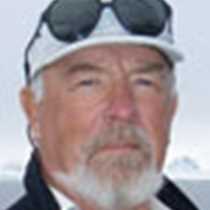Port Charcot, Booth Island
We made good time overnight coming north up the Grandidier Channel into the Penola Strait before turning north along the west side of Booth Island.
The strong wind gradually increased as we dropped anchor in Port Charcot (65. 04’ S 64.03’ E) where Commandant Jean-Baptiste Charcot wintered his expedition ship, Le Francois, in the fast ice on the northern side of a small peninsula in 1904. With our ship tucked in close to the ice in the shelter from the increasing NNE wind we were able to land some groups ashore on the ice worn granitic rocks lightly glazed with a slippery coating of penguin guano while other brave guests went Zodiac cruising.
Up on the isthmus above the pink and green algae covered snow, the ridgeline was lined with gentoo and a few Adélie and chinstrap penguins. On venturing up to the ridge with Karen, the full blast of the gale became apparent and bowled over a few of the guests who had not taken full advantage of the excellent food served by the galley. A challenging experience!
The site of the Charcot Expedition huts was well clear of snow this year and the debris from the magnetic hut, the base buildings and an old wooden boat are all that remain of one of the earliest significant scientific expeditions to the area.
Eduardo and Kendra, with ten brave souls, ventured on a climb up to the headland peak on which Charcot’s party built a survey cairn. They soon discovered what a full blown gale really felt like! Trying to walk round the 8’ high cairn was impossible without hanging on as we were plastered against the rock by estimated 70-80 knot gusts. The climbers were able to sit in the lee of the summit and admire ice bound Booth Island, the Danneborg Islands forming a pattern of skerries to the west and the grounded bergs in the bay near the ship. Horizontal heavy rain added to the experience as we descended.
Just offshore, the divers with Lisa were delighted to have a leopard seal visit them and swim a graceful ballet around them for awhile before heading off on its business elsewhere.
The cruising parties braved the elements in good spirits viewing the icebergs from sea level until driving rain triggered the homing response with a long windy and wet beat back to the ship.
The ship departed at midday through the Lemaire Channel where the headwind reached 60 kts and by the time we were in the Neumeyer Channel heavy snow reduced visibility to 100 yards. Once in the Gerlache Strait we crossed over to the Errera Channel and sailed past Cuverville Island which afforded us some protection from the wind.




